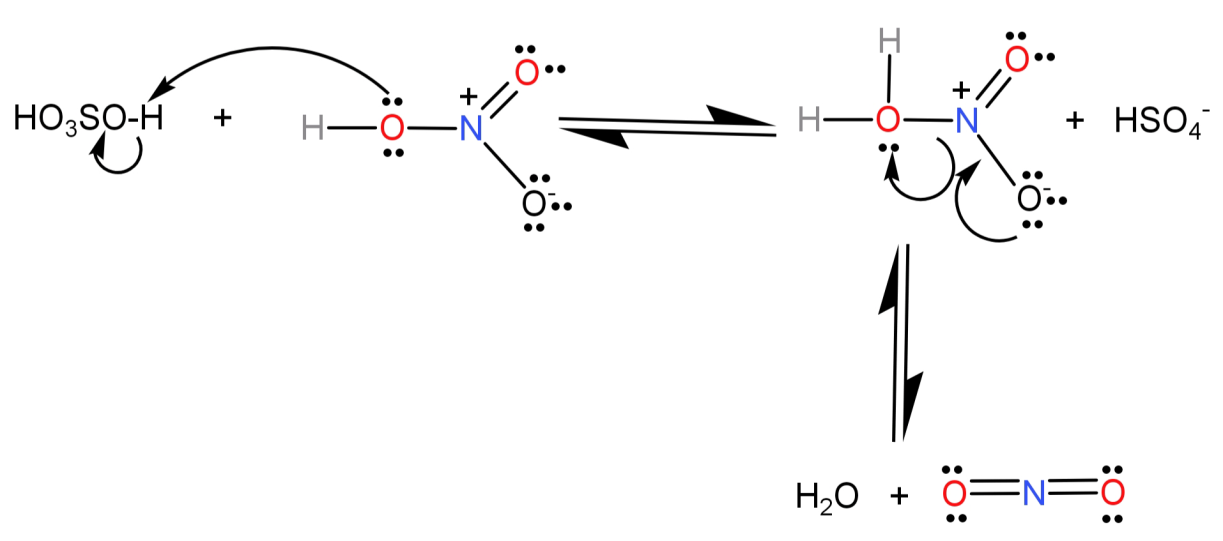
Nitration of benzene is:
(A) Nucleophilic substitution
(B) Nucleophilic addition
(C) Electrophilic substitution
(D) Free radical substitution
Answer
498.3k+ views
Hint: In this reaction benzene is reacted with concentrated nitric acid and concentrated sulphuric acid. Conc. sulphuric acid being strong donates a proton to nitric acid to form an ion which attaches to the benzene ring.
Complete step by step answer:
-First of all let us see what is meant by nitration of benzene.
A reaction where benzene (

-We will now talk about the mechanism of this reaction:
Step-1) The two strong acids:
Step-2) Now benzene will react with this positively charged nitronium ion (electrophile) and leads to the formation of an arenium ion (by breaking one of the N=O bonds).

Step-3) Finally the arenium ion loses a proton to a lewis base (to regain its aromaticity) and leads to the formation of our final product nitrobenzene (

Here we can see that we have replaced a hydrogen atom from the benzene ring with a strong electrophile (nitronium ion,
So, the correct answer is “Option C”.
Note: An electrophile is an ion which is itself positively charged and gets attracted to electron rich atoms or molecules, while a nucleophile is an ion which itself is negatively charged and gets attracted to electron deficient atoms or compounds. So, in an electrophilic substitution reaction an electrophile replaces another electrophile.
Complete step by step answer:
-First of all let us see what is meant by nitration of benzene.
A reaction where benzene (

-We will now talk about the mechanism of this reaction:
Step-1) The two strong acids:

Step-2) Now benzene will react with this positively charged nitronium ion (electrophile) and leads to the formation of an arenium ion (by breaking one of the N=O bonds).

Step-3) Finally the arenium ion loses a proton to a lewis base (to regain its aromaticity) and leads to the formation of our final product nitrobenzene (

Here we can see that we have replaced a hydrogen atom from the benzene ring with a strong electrophile (nitronium ion,
So, the correct answer is “Option C”.
Note: An electrophile is an ion which is itself positively charged and gets attracted to electron rich atoms or molecules, while a nucleophile is an ion which itself is negatively charged and gets attracted to electron deficient atoms or compounds. So, in an electrophilic substitution reaction an electrophile replaces another electrophile.
Recently Updated Pages
Master Class 9 General Knowledge: Engaging Questions & Answers for Success

Master Class 9 English: Engaging Questions & Answers for Success

Master Class 9 Science: Engaging Questions & Answers for Success

Master Class 9 Social Science: Engaging Questions & Answers for Success

Master Class 9 Maths: Engaging Questions & Answers for Success

Class 9 Question and Answer - Your Ultimate Solutions Guide

Trending doubts
Give 10 examples of unisexual and bisexual flowers

Draw a labelled sketch of the human eye class 12 physics CBSE

Differentiate between homogeneous and heterogeneous class 12 chemistry CBSE

Differentiate between insitu conservation and exsitu class 12 biology CBSE

What are the major means of transport Explain each class 12 social science CBSE

Why is the cell called the structural and functional class 12 biology CBSE




